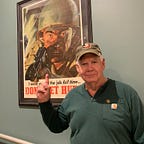New People’s Revolution
President Ferdinand Marcos had ruled the Philippines with an iron grip, accompanied by widespread graft and his signature corruption for close to twenty years prior to my arrival at Subic Bay. Marcos had over time siphoned hundreds of millions of dollars in financial aid provided by the United States as well as monies from international organizations. His rampant criminal acts culminated with the assassination of Presidential Contender and political rival Benigno Aquino Jr. Although “never solved ‘’, Aquino’s assassination was committed in full view of the world on the Tarmac of Manila’s International Airport in 1983. Resultant political and popular pressure for Marcos to “pass the torch” resulted in a “snap Presidential election” in 1986.
Benigo Aquino’s widow, Cory Aquino took her husband’s place and ran on the Presidential ballot. By all accounts, Cory Aquino won the actual vote. Marcos however, had “rigged; the election with the resulting fraud being so obvious that Commission Election representatives, monitoring the vote, stepped away from their computer stations and walked out while television crews filmed their actions.
After the election, tensions grew dramatically. The claiming of the election victory by Cory Aquino reverberated throughout the country. Within a short time, the Philippine Army Chief of Staff General Ramos along with Secretary of Defense Juan Ponce Enrile aligned with Aquino. Together and with the overwhelming majority of the Philippine Armed forces, they staged a “bloodless coup” and seized Camp Crame and Camp Aguinaldo.
Feeling betrayed, Marcos then ordered AFP Chief of Staff General Ver to use the Military to “crush the revolt”. A subsequent conversation, between Marcos and the Governor of Zambales (Gov. Magsaysay’s), disclosed that Marcos was intent on using force to quell the rebellion was inadvertently overheard by N.I.S. Agent Chris Chalimer. Subsequent
reporting of the conversation’s content reached the White House resulting in President Ronald Reagan’s interdiction. A call was placed by President Reagan telling Senator Paul Laxalt to inform Marcos “to cut and cut clean”. As a result, arrangements to relocate Marcos and his wife Emelda to Hawaii were solidified.
“WASHINGTON (AP) _ Sen. Paul Laxalt, a close friend of President Reagan, said he told Ferdinand E. Marcos it was time to ″cut and cut cleanly″ after the embattled Philippine leader telephoned him desperately searching for ways to cling to power”.
Three days on the ground at Subic Bay Philippines had allowed barely enough time for my jet lag symptoms to dissipate. A quick discussion with Dan McBride, Subic’s Agent in Charge, had me packing for a road trip to Manilla. The ride from Subic to Manilla provided an opportunity for me to become familiar with Agent Jeff Walton. Jeff was an experienced Agent who had early in his career been indoctrinated into NIS’s Foreign Counterintelligence mission. His demeanor and competency embodied all the concepts of a “Quiet Professional” and I felt fortunate to have him as my traveling companion.
Our arrival in Manila was late evening and we immediately secured lodging at the Mandarin Hotel for the evening. Walking into the lobby area of the Mandarin spelled “unbelievable” for my exposure to 5-star facilities
had previously been nonexistent. As we traversed to our assigned rooms I followed Jeff’s lead in identifying routes of egress in the case of unexpected emergencies. Avoiding elevators and identifying exit stairs are fundamental protocol concepts. My Army training coupled with Oklahoma Bureau
training and experience had not included stays in high-rise hotels situated in large metropolitan areas. Obviously, a bonafide “revolution” occurring while staying in a 5-star high rise only amplified the uniqueness of my new career path. My position as an Agent with N.I.S. was quickly becoming everything I had hoped it would be.
Early morning brought familiar noises that abruptly placed my mind and body into full alert. The unmistakable sound of helicopters caused me to immediately open the curtains of my room. Eyeballing cobra gunships racing over my hotel made for a “get it together moment”. Link up with Jeff followed and as we made our way to the roof it was evident that gunships were bearing down on the Presidential Compound. No engagement of weapons could be detected but their menacing flight path was sending a clear message to all in observance.
A quick scramble down to the parking area and a hurried ride to the Manila N.I.S. Office followed. My introduction to the Agent in Charge, Steve Einsel, was accomplished as both of us entered a vehicle headed for a local Constabulary Headquarters. As Einsel conversed with the local commander I realized we were trying to determine which way the Philippine Military’s allegiance was going to fall. Support for President Marcos or for the challenger Aquino was the question. As we exited HQ and headed to our car gunfire broke out. Attempts to confirm who and why the shooting was occuring only hastened our exit from the area. Radio traffic disclosed some details as to which power figures had committed and which had not. Arrival back at the N.I.S. Office allowed access to critical dispatches revealing U.S. demands forwarded to Marcos to “stand down”.
A late-night dinner with Jeff followed and as I ate my primary thought was this “Revolution Rodeo” was over before it really started. Settling in back at Subic Bay allowed time for reflection. Thoughts centered on my first week in the Philippines — “put me in coach I want to play”.
